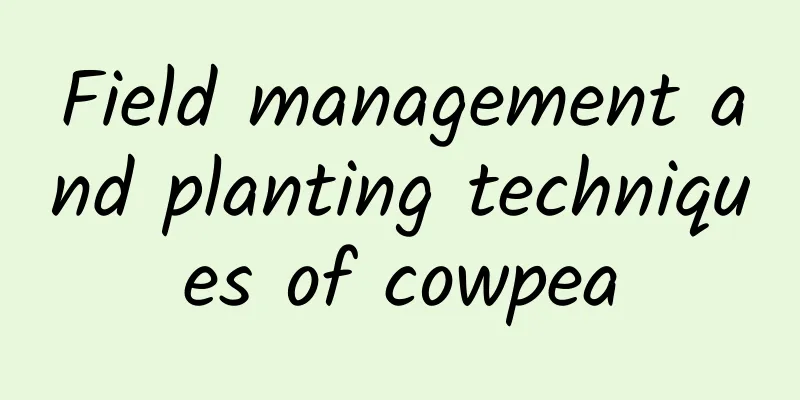Field management and planting techniques of cowpea

|
Cowpea is a vegetable that everyone is familiar with. Here is an introduction to the field management of cowpea: Thinning or replanting:When the seedlings grow 1 to 2 true leaves, select 2 strong seedlings in each hole and remove the rest. After the seedlings are transplanted and survive, if there are any missing seedlings, they should be supplemented in time. Top dressing and watering:For transplanted cowpeas, the first topdressing can be carried out after they are established and survive; for direct seeding, the first fertilization can be carried out after the seedlings emerge from the soil. . Apply 750 kg of 20% decomposed human feces and urine per 667 square meters (1 mu) to promote the growth of seedlings. After the vines are pulled out and before the vines are back, a heavy fertilizer should be applied once, 1500 kg of 30% to 40% decomposed human and animal feces and urine, 15 kg of superphosphate and 100 kg of plant ash per 667 square meters (1 mu). Superphosphate and plant ash should be applied in furrows between plants or rows, and covered with soil after application; human and animal feces and urine can be applied by drenching the roots. This fertilization plays an important role in promoting flowering and pod formation. When the fertilizer demand is large after budding, flowering and harvesting, it should be top-dressed once every 5 to 7 days for 3 to 4 times in a row, and 750 to 1000 kg of decomposed human and animal feces and urine should be applied per 667 square meters (1 mu) each time. If human and animal feces and urine cannot be applied due to heavy rain, 10 to 15 kg of ammonium sulfate or 5 to 10 kg of urea can be applied in the hole between the rows. Before flowering and fruiting, the main method is to squat and till the seedlings to promote the root system to grow deep and control the growth of stems and leaves. After pod formation, the bed surface should be kept moist. Spring cowpea cultivation is in the rainy season. In addition to topdressing and watering, watering is generally not done alone. When there is too much rain, attention should be paid to clearing ditches and draining. In the late growth period of summer cowpea and the early growth period of autumn cowpea, it is in the hot and dry season. Attention should be paid to timely watering or frequent application of thin, decomposed human and animal feces and urine. Cultivation and soil cultivation:After the seeds are successfully planted or after the seeds have germinated and the seedlings have fully grown, before the scaffolding is erected, 2 to 3 intertillages should be carried out, depending on the compaction of the soil, to form loose soil, which is conducive to the occurrence of rhizobia and root growth. During the last intertillage, the soil should be properly cultivated to facilitate the occurrence of lateral roots. Trellising and pruning:When the cowpea vine grows to 20-35 cm, it is necessary to build a frame in time, and the frame height should be above 2.5. After the frame is built, the vines should be guided in time. The vine guidance should be done on sunny days at noon or in the afternoon, and it should not be done when the dew has not dried or on rainy days to prevent them from breaking. The method of pruning is: all the side buds of each node below the first inflorescence of the main vine should be removed, and all the weak leaf buds above the first inflorescence should also be removed to promote the growth of flower buds at the same node. All side branches should be topped as soon as possible, leaving only 1-3 nodes to form inflorescences. When the main vine grows to the top of the frame, it should be topped and topped to promote the formation of flower buds between the leaf axils, so that nutrients can be concentrated to form more pods, and it is also convenient to pick pods in the future. For semi-climbing and dwarf cowpea varieties, we generally do not build trellises to guide the vines, nor do we prune them. We just let them grow naturally on the ground in spring. |
<<: Steps to cook spicy minced meat and eggplant
>>: Bitter melon healthy weight loss recipes
Recommend
How to make Sichuan Fritillary Stewed Pear How to make Sichuan Fritillary Stewed Pear
The air in cities is not good now, and it is easy...
Laser Interferometer Gravitational-Wave Observatory_LIGO How is it? Laser Interferometer Gravitational-Wave Observatory_LIGO review and website information
What is the Laser Interferometer Gravitational-Wav...
Plum Blossom Porridge
What I am going to introduce to you below is some...
Black bean types pictures
Do you know the types of black beans? If you don’...
What is Beiersdorf like? Beiersdorf company reviews and website information
What is Beiersdorf's website? Beiersdorf (BDF)...
The efficacy and storage methods of litchi
Lychee is a southern fruit that is available in e...
The nutritional value and efficacy of onions The medicinal value of onions
Although onion is a kind of condiment, it has man...
The efficacy and function of winter melon peel
I believe everyone has eaten winter melon, but mo...
Several diseases of shiitake mushrooms
Friends who have grown some vegetables and crops ...
Benefits of Black Rice and Almond Porridge
What I am going to introduce to you below is the k...
What foods are there for men to eat to improve their sexual performance?
Why do men need to strengthen their sexual functi...
How to make delicious pork rib soup
Pork rib soup is a very good nourishing soup. Its...
Stuffed Winter Squash Recipe Nutrition and Preparation
Many people like to eat stuffed winter melon, so ...
Who can't eat steamed apples? Side effects and taboos of steamed apples
Apples are sweet and crispy, and are a very popul...
What is the International American Football Association like? International American Football Association reviews and website information
What is the website of the International Federatio...









